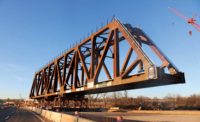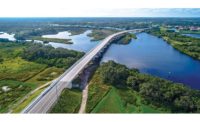BNSF Railway Fort Sumner Double Track and Pecos River Bridge
Fort Sumner, N.M.
Best Project
Owner/Developer: BNSF Railway
Design Firm: Wilson & Co.
General Contractor: SEMA Construction Inc.
Subcontractors: ATS Drilling; 814 Solutions LLC; K. Barnett & Sons Inc.; CMC Steel Fabricators-West
A 1,576-ft, 20-span bridge crossing the Pecos River is the central component of the three-mile double-tracking project for Fort Worth-based Burlington Northern Santa Fe just outside Fort Sumner, New Mexico.
Delivered in an accelerated schedule of 178 days and on budget by Centennial, Colo.-based SEMA Construction Inc., the project added the longest bridge on the California-to-Oklahoma segment of BNSF track, increasing capacity while also improving efficiency on the railway’s southern transcontinental Los Angeles to Chicago route. Now only four miles of single track remain on the corridor.
The scope also included a 221-ft, eight-span bridge over Truchas Creek; a 91-ft, three-span bridge above Highway 60; a 160-ft, multiplate arch tunnel through the embankment; and culvert extensions for a regional irrigation canal and maintenance road. The largest piece, the Pecos River bridge, incorporates 19 approximately 80-ft-high piers, or bents, whose telescoping design recalls the tapered piers of the adjacent early-1900s bridge.
Challenged by heights and frequent high winds, the construction team of 150 workers, with 80-plus pieces of heavy equipment, moved 1.5 million cu yd of earthwork; completed 70,000 cu yd of slope stabilization; placed 25,000 cu yd of subballast; and poured 8,740 cu yd of concrete.
Developing the alignment and profile for the crossing of the river was particularly challenging, explains Marc Devos, senior transportation project manager for Denver-based Wilson & Co., the design engineer.
“The alignment of the second main track would normally be 20 to 25 ft from the existing main track, but due to environmental and historical considerations at the Pecos River, the track centers were widened to 350 ft,” he says. “This allowed for maintaining the sight lines to the historic existing bridge while also limiting impacts to the river and a protected fish species.”
Related Article: Pursuing Excellence Drives Best Projects






